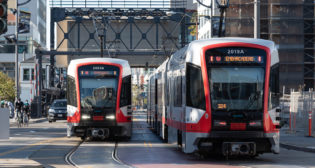
Transport Canada resumes modest rail safety regulation
Written by David Thomas, Canadian Contributing EditorAfter a train crash of criticism by Canada's Transportation Safety Board and the country's auditor-general, Transport Canada is softly moderating its three-wise-monkeys approach to railway regulation.
Henceforth, according to an Oct. 29, 2014 directive by Canada Transport Minister Lisa Raitt, the national rail regulator will see, hear, and speak about evils in the design and application of the “safety management systems” that were at the heart of the government’s long-standing transition from government rule-making to railway self-regulation.
Problem was, according to the government’s own safety and financial watchdogs, those self-prescribed systems were often inadequate, unchecked by experts, and in the absence of oversight sometimes simply ignored by rail operators.
Forced by law to respond to the damning TSB conclusions with respect to the causes of the July 6, 2013 oil train catastrophe that killed 47 people in downtown Lac-Mégantic, Quebec, Raitt announced that her department will henceforth actually review and grade the self-regulatory safety management plans and is hiring 10 auditors to do so.
The minister began her announcement by directly contradicting the TSB’s core conclusion that Transport Canada was the prime culprit in the Lac-Mégantic calamity. Instead, she blamed the operating employees of the defunct Montreal, Maine & Atlantic Railway: “The rules were not followed and criminal charges are pending against those who may have been responsible.”
The actual truth, according to the August 19 final report of the autonomous TSB investigators, was that the ultimate responsibility for Lac-Mégantic lay with the laxity of Transport Canada itself: “If the guard dog doesn’t do its job, then indeed it is to blame,” said Jean Laporte, TSB Chief Operating Officer.
Raitt announced no terminations or other disciplinary actions against Transport Canada employees. Nor did she accept any ministerial responsibility for Transport Canada’s well-documented maladministration. Her only reluctant nod to responsibility was: “We know there are weaknesses with respect to the auditing of safety management systems.”
In addition to hiring auditors, Transport Canada will re-regulate the railways in three more ways:
• Locomotive engineers and conductors must consult a government chart specifying how many handbrakes must be set when parking trains of particular tonnages on particular grades. For example, a 22,000-ton train parked on a 1.4 percent grade, must have handbrakes manually set on at least 94 cars. All air brakes must be released and a “push-pull” test the adequacy of the handbrakes. In addition, at least one derailer, wheel choc, chains or other restraint must physically restrain the train;
• Short-line railways must produce training plans for their employees;
• Transport Canada will analyze crude oil shipments along the route from wellhead to refinery, and subsequently “conduct a targeted inspection campaign to verify the classification of rail car shipments.”
The texts of the new emergency and ministerial orders were to be published later in the day.
Raitt did note the news conference presence of Lac-Mégantic Mayor Colette Roy-Laroche (though the painfully unilingual minister could not remember her name) and she offered a nod in bloodless bureaucratese to the town’s citizens “as they go through their loss process.”
With the announcement of these final measures, Transport Canada, for its part, has gone through its own post-Lac-Mégantic process and has pronounced itself essentially blameless.



